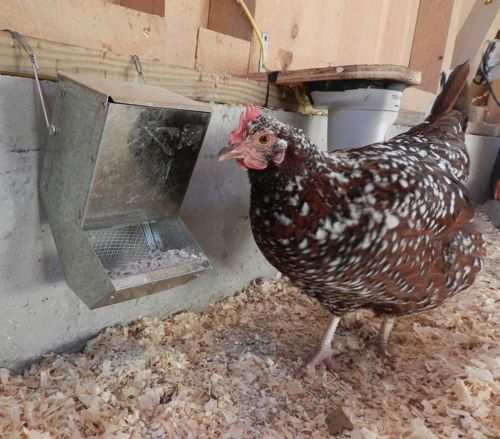Chickens are designed to make eggs, and they are very good at it – commercial layers will produce upwards of 300 eggs in the first year. Your backyard hens will lay far fewer, but each and every egg requires a lot of inputs in order to come out right. Chickens are designed to lay eggs, day in and day out, but it’s depleting and they need our help. It’s up to us to give our hens the raw materials essential for them to do the alchemy that makes eggs.
The egg shell is the part we see first and worry about. Shells should be hard and smooth. Thin-shelled, rough and wrinkly eggs are signs that something is off. The building blocks of egg shells are calcium, phosphorous and vitamin D. Commercial pellets have these minerals in the right amounts – that is, if your hens eat nothing but this feed. However, free-ranging chickens, who get treats and kitchen scraps, grass and bugs, will eat fewer pellets and so, proportionally, don’t get enough calcium. Free-ranging hens that try to get all the minerals they require from the pellets will overeat. It also turns out that hens need more calcium during periods of hot weather – exactly when they become listless and go off their feed. Fortunately, studies show that hens will consume the calcium they need if it is offered free-choice.
Oyster shell, ground into gravel-sized bits, is the best supplement as it provides calcium readily absorbed by your chickens’ digestive systems. You can buy oyster shell by the bag at your feed store. It’s not expensive, but you don’t want it to go to waste. There are days when the hens won’t eat any, and others when they scarf it up. Tossing it on the ground or mixing it in the feed isn’t efficient. I’ve come up with a tidy solution. I use a rabbit feeder, hung in the barn.
Florence says it’s just right. After a few pecks she goes outside. After all, she needs her daily dose of vitamin D, too. My girls don’t have to get that from their feed- fresh air and sunshine are part of their healthy diet.


I use the same rabbit feeders! I have two, one for grit and one for Oyster shell. They work great! very little waste.
The process of egg laying is amazing to me – like watching airplanes taking off – how can that be possible! Happy New Year Terry to you and all those at Little Pond Farm.
Wonderful information. I do keep a bowl of Oyster shells and another for grit. I strive to keep my girls happy during the cold winter months. I find it interesting that on the darkest day of the year my hens all produced an egg. Hens always keep ya guessing. Happy New Year to you and yours, Julie.
This is an excellent post Terry… a good reminder that eggs don’t just happen!
Our hens have a DIY grit and shell feeder hanging under their chalet bedroom. Isn’t it amazing that they seem to know what they need more of… “a little of what you fancy does you good” :-)
Celia
I have always offered free choice oystershell. But there have been spells when they just don’t eat it. I start getting thin shells/broken eggs. I’ve heard from a few other chicken owners that they’ve had this problem too.
My solution was to take the very fine grains of the oystershell and sprinkle it over their daily fish ration. It sticks well to the ground raw fish, and the fish disappears in seconds. Within a few days, shells are stronger and soon they are back at the oystershell feeder.